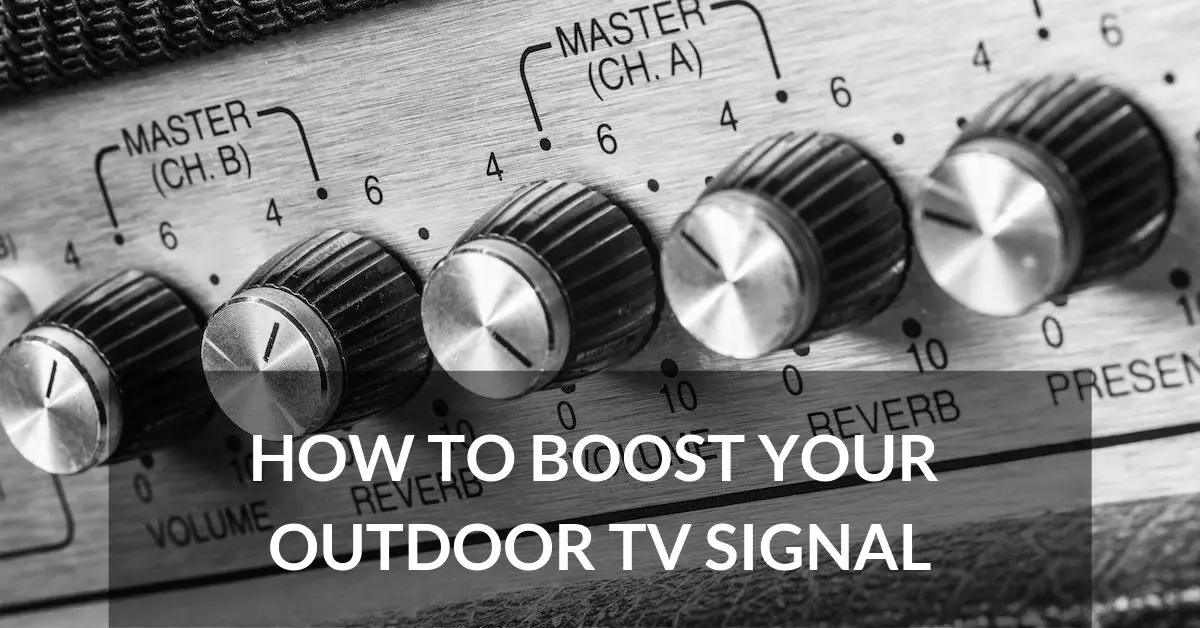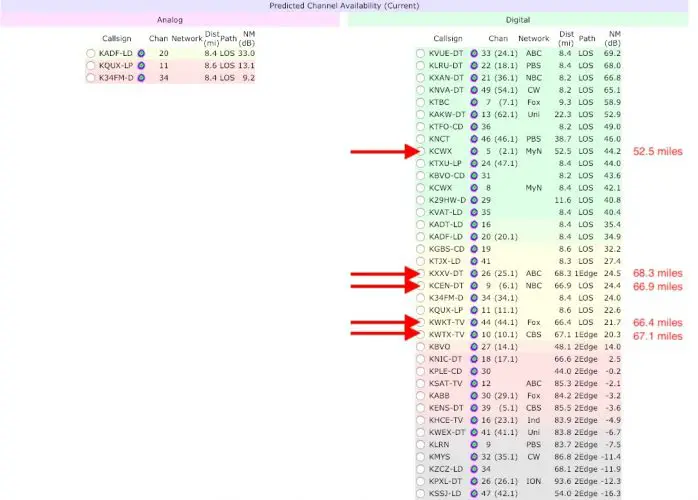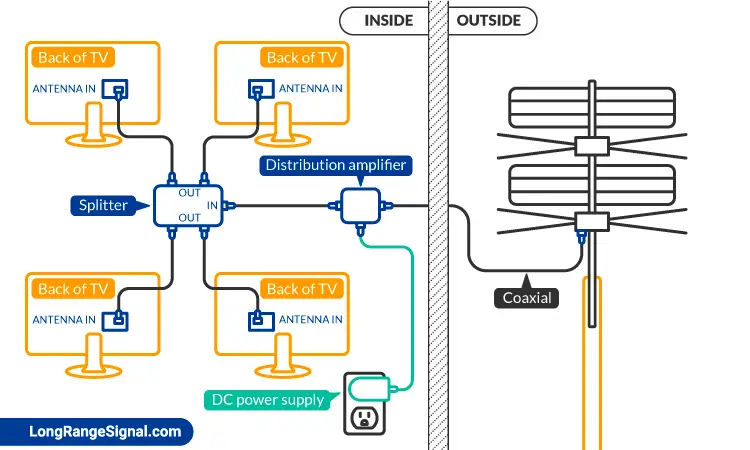
*As an Amazon Associate we may earn from qualifying purchases when you buy through links on our site.
At one point or another you might’ve experienced reception problems and wondered how you could pick up more channels.
In this case, you might’ve considered getting a TV antenna amplifier.
An amplifier is an AC-powered device that applies electric current to your antenna coaxial cable to boost your TV signal and improve reception under certain conditions, and it functions for various antenna types.
For example, if your TV antenna is located indoors and is weakened due to the walls of your home, a TV antenna amplifier works as a signal booster and can increase your reception quality.
But are TV antenna amplifiers the magic bullet for all reception issues?
I’ve personally found that a TV antenna amplifier has improved my TV reception by increasing the number of available channels.
By some estimates, a properly installed amplifier can help you get up to 10-20% more channels.
But they won’t work in all circumstances, and may even hinder your reception in some cases.
Below, I’m going to describe where and when it makes sense to use an amplifier, as well as situations when you shouldn’t.
What is a TV Antenna Amplifier?
Let’s start with the basics.
An amplifier is a device that strengthens the televison signal travelling down your antenna or along the coaxial cable to your TV or converter box.
Notice I said, “travelling down your antenna or along the coaxial cable.” That’s key to understanding amplifiers.
They strengthen your already-received signals, but they won’t help you get broadcasts you otherwise wouldn’t receive at all (say, from another country or from an alien galaxy).
You normally install an amplifier by attaching it somewhere along the line from your antenna to your TV, and then plugging the amplifier in to an AC power outlet.
The power it’s adding to the signal is referred to as amplifier gain, which is measured in decibels (dB). (Elsewhere on this site I’ve also talked about “antenna gain (dB)” but that’s a different kind of gain — it’s basically the passive, receptive power of the TV antenna itself based on its own design.)
A good preamplifier that I always recommend to people is the RCA TVPRAMP1Z (shown below). Since you can use this thing to power both a VHF and UHF antenna at the same time, it offers two different (max) gain figures for these frequencies: 16 dB for VHF and 22 dB for UHF.
This means it can add up to 22 dB of extra gain – for UHF signals – to offset any losses (“signal attenuation”) along the line caused by a lengthy cable, distant transmission towers, etc. – below I give some loss of the signal scenarios along with estimated loss numbers.
TV Antenna Amplifier vs. Preamplifier
What makes terms relating to antenna amplification confusing is that people often use different words when they mean the same thing.
For example, people talk about boosting their reception, so they call it a TV antenna booster, or an aerial booster. A TV signal booster is actually an amplifier. Some refer to them as amps.
Now let’s talk about true distinctions. There are two types of amplifier:
- A preamplifier attaches directly to the mast or TV antenna itself, and boosts the signal immediately received by the antenna
- A distribution amplifier boosts the signal in conjunction with a splitter device that you install in order to split the signal among multiple televisions. Unlike a preamplifier you attach to an antenna outside, a distribution amplifier is usually located indoors (e.g., directly after the coaxial cable enters the house and before or after the splitter)
Normally you’d use either one of these, although there are situations where you might consider using both, which I describe further below.
When Do You Need a TV antenna Amplifier?
First, let’s talk about when you won’t need an amplifier.
Have you noticed that many long-range directional TV antennas—like the RCA ANT751R—don’t come with a preamplifier?
Such TV antennas have an antenna gain that’s sufficient for receiving most, if not all the stations within their range, and without resorting to electrical amplification of the signal.
An antenna’s gain measures how well the TV antenna converts radio waves arriving from a certain direction into electrical power.
Thus, its antenna gain means it probably won’t need extra amplifier gain to boost the received signal.
But that’s just speaking about the TV antenna itself.
Nevertheless your particular situation may be difficult for antenna reception. You may not be satisfied with the number of channels you’re getting.
For instance, you may have looked at a signal report for your location from tvfool.com and found several more stations (within the line of sight and range of your TV antenna) that you’re not receiving.
In these cases, an amplifier may be beneficial if:
- The length of the coaxial cable from the antenna to the television is longer than 50 feet
- You’re distributing the television signal to more than two TVs in different rooms
- You’ve installed the TV antenna indoors or in the attic, and are concerned about too much interference from your attic walls or roof
- The distance to the nearest transmission tower is greater than 20 miles
What Causes TV Signal Loss?
Let’s look at points #1 and #2 above, which represent some of the biggest reasons for getting an amplifier: you need to overcome the loss of the signal along the line from the antenna to your TV sets.
Think of your antenna and coaxial cable, and all the devices attached to them as a leaky system.
Your signal, once received by the antenna, is losing signal strength the farther it travels down the line.
It’s also getting weakened the more it’s split up or dissipated by attached devices such as grounding blocks (for surge protection) and splitters.
Believe it or not, the signal quality even gets weakened (slightly) as it jumps across connections between the cable and devices such as splitters or your TV sets.
Below are some attenuation scenarios and estimated loss numbers along your TV coaxial cable (keep in mind these aren’t to be taken as exact figures and may differ greatly from your own situation).
Signal Loss Numbers
|
Description |
Signal loss (decibels) |
|---|---|
|
A high UHF signal (e.g., radio frequency channels 14-69) travelling along 50 feet of RG6 coaxial cable | ~ 2.5 dB |
|
2-way splitter | ~ 3.5 dB per output port (~7 dB total loss) |
|
4-way splitter | ~ 7 dB per output port (~28 dB total loss) |
|
F-type connector on a television set for the coaxial cable | ~ 0.5 dB per connector |
Why Are These Numbers Important?
You add up these numbers to arrive at an estimate of the total signal loss along the coaxial cable. Your amp should offer sufficient amplifier gain to offset this sum total.
The better you can estimate this number, and the more precisely the amplifier gain matches this number, the higher the quality of the reception you’ll get.
If you were to just buy and install the most powerful amp out there, which greatly exceeded your loss of signal, you’d again end up with poor reception.
Why? Because too much noise would be introduced into the TV line.
Types of Amplifiers
The following video from Channel Master explains the purpose of preamplifiers and distribution amplifiers:
With permission from Channel Master
Preamplifiers
Many people first consider getting a preamplifier (or simply “preamp”) to give the signal a boost directly at the antenna before it travels along the coaxial to the TV.
Usually a preamp will provide sufficient offset for signal loss and no other steps for boosting signal will be needed.
IMPORTANT: Many people who buy a preamplifier decide to install it further away from their antenna. Ideally, a preamplifier should be installed on the antenna mast for best results. The farther away a preamplifier is from the TV antenna, the less performance it will have.
Distribution Amplifiers
In another scenario, you may want to distribute a signal to several rooms in the house, and find that the signal is weakened (somewhat) as a result of attaching, say, a 4-way splitter to a long coaxial.
A distribution amplifier would potentially offset this kind of signal loss from a splitter. Some splitters are actually combination amplifier/splitter, like this 4-Port DTV Distribution Amplifier (CDA4).
It provides a boost of 7.5 dB per output port, completely overcoming the traditional signal loss of a passive 4-way splitter.
Amping Up Your TV Reception
You may notice you’re receiving fewer channels when compared with TV Fool’s signal report for your location.
For example, let’s say you’ve got an 70-mile multidirectional antenna, but you’re not picking up several channels that are apparently within range of your antenna.

Maybe there’s a dense forest between your location and these stations. Or perhaps your antenna is installed in the attic, where materials such as insulation or your roof’s radiant barrier may be interfering with signal.
In this situation, you might consider attaching an AC-powered preamplifier to your antenna’s mast to boost signals weakened by interference caused by physical obstacles.
Usually this will be enough to provide clear reception of TV signals.
But what if you’re using a splitter to distribute the TV signal to, say, four rooms in your house over coaxial cables that run over 50 feet to the TVs?
If you find that splitters and long cable runs might be causing you to lose additional channels, then you might additionally consider attaching a distribution amplifier to the cable before the splitter (or buying a combo splitter/amplifier).
Lastly, make sure the amplifier you’re getting (regardless of type) matches the frequency band your antenna picks up.
For instance, if your antenna receives both UHF and VHF signals, read the amp’s specs to ensure it allows both signals to pass through it (some amps sold only allow either UHF or VHF signals through).
How to Hook Up a TV Antenna Amplifier
Attaching a preamplifier or distribution amplifier to an antenna cable isn’t terribly difficult.
Depending on its type, you install it at a certain location on the line to your TV.
You should however ensure there’s an AC power supply like a wall socket available nearby.
Installing an Antenna Preamplifier
You typically attach a preamp at the TV antenna location (i.e., to the antenna or antenna mast) where it boosts the signal at the received source.
You plug some brands of preamplifier directly into an AC power supply; others include a separate device called a power inverter or power inserter that feeds electrical power up the coaxial cable to the preamp attached to the antenna mast.
A power inserter allows you to use an indoor power supply (preferably closer to the TV) to power the preamp, rather than having to plug the preamp (which likely resides on your antenna mast) into a power supply on or near the roof.

Installing a Distribution Amplifier
Distribution amplifiers are typically used together with a splitter for distributing TV signal to several televisions.
As such, you normally install a distribution amplifier before the splitter in order to boost signal before it’s divided among several TVs and experiences loss of the signal.
The diagram below depicts the splitter and distribution amplifier as separate devices, but many people buy a combined device that’s plugged into the power source.

Too Much Signal Amplification
Someone once said that too much of a good thing is wonderful, but it’s definitely not the case with amplification of TV signals.
Using a preamplifier when you’re less than 10 miles away from transmission towers might actually hamper your reception.
Amplifying TV signals that are already very strong will introduce a high level of noise in your signal and degrade it.
Se la tua antenna è amplificata e credi che un segnale troppo forte potrebbe interferire con la sua ricezione, semplicemente disconnetti l’amplificatore dalla sua fonte di alimentazione e fai uno scan dei canali sulla tua TV o sul tuo convertitore TV. Se il numero di canali aumenta dopo lo scan, è un chiaro segnale che il tuo amplificatore stava causando problemi di ricezione.
Do Amplifiers Work?
To sum up, both preamplifiers and distribution amplifiers can be effective in certain situations. Amplification strengthens marginal, already-received signals.
You should understand the potential for signal loss along the coaxial cable to your TV, and how a TV antenna amplifier can offset this loss.
But TV antenna amplifiers also have limits, and you should be aware of the effects of over-amplifying your signal.


